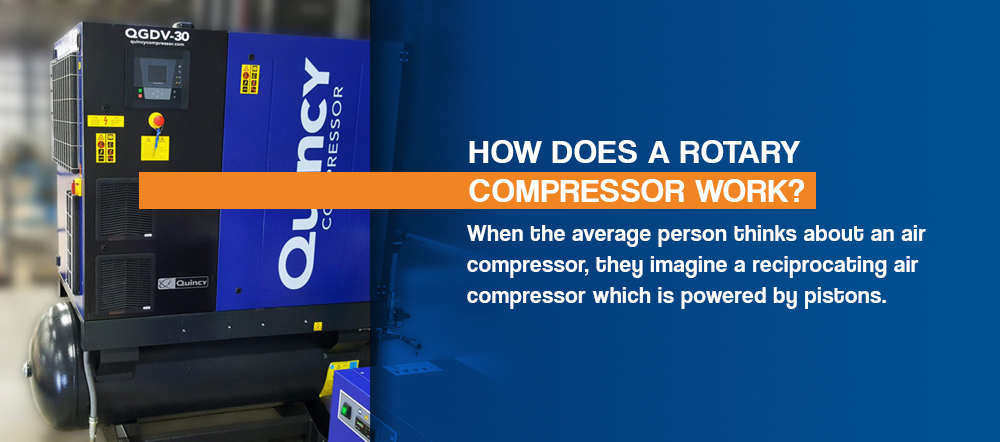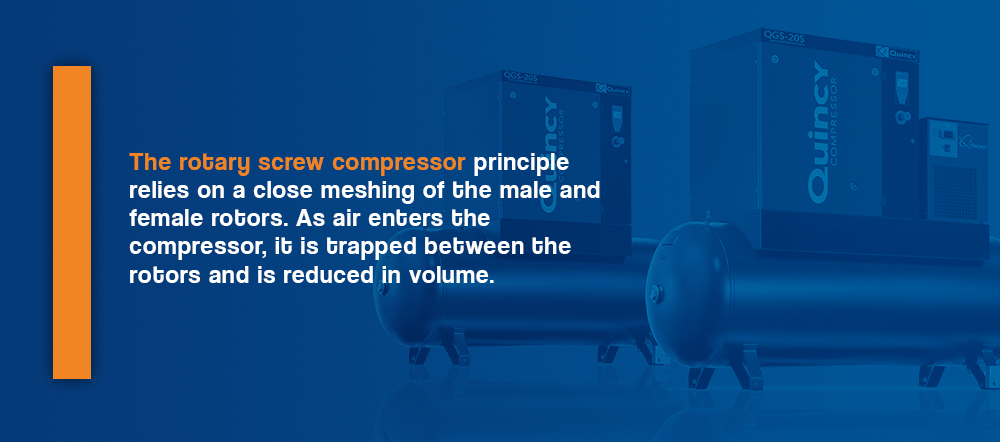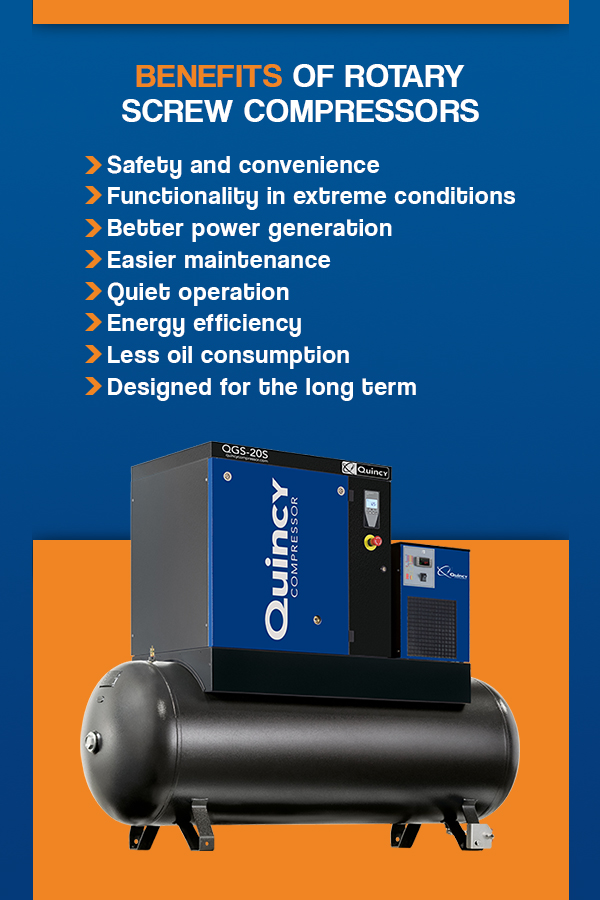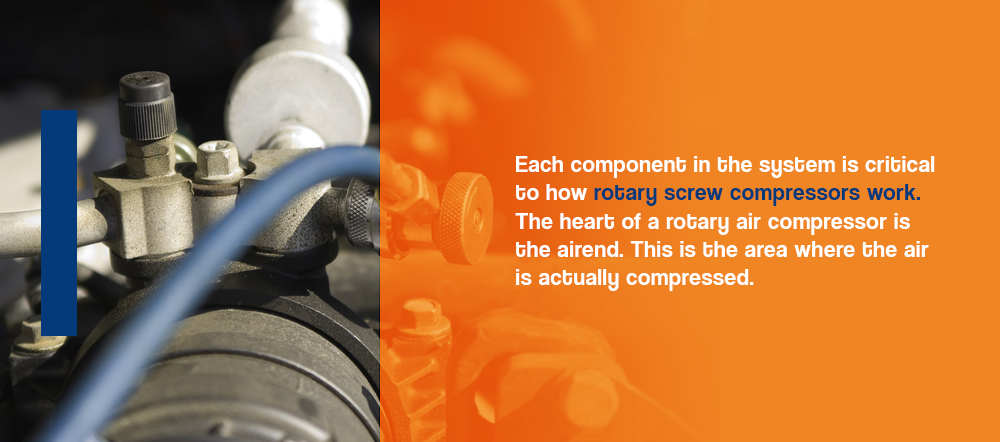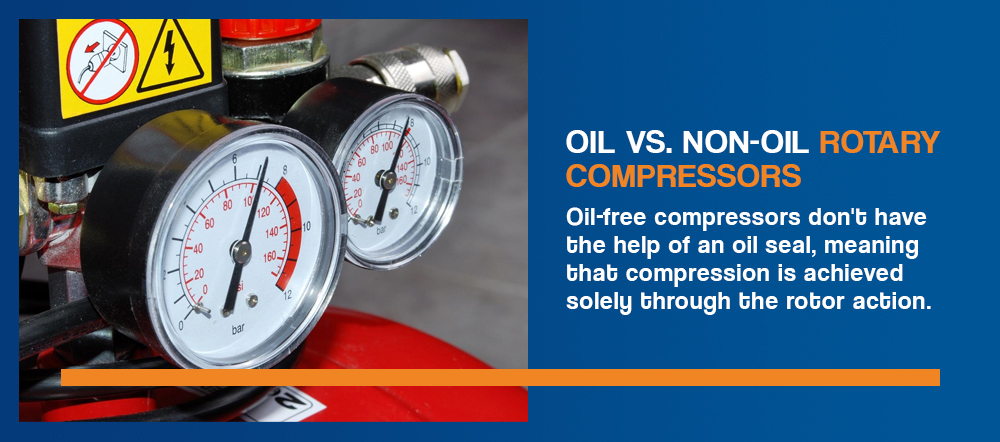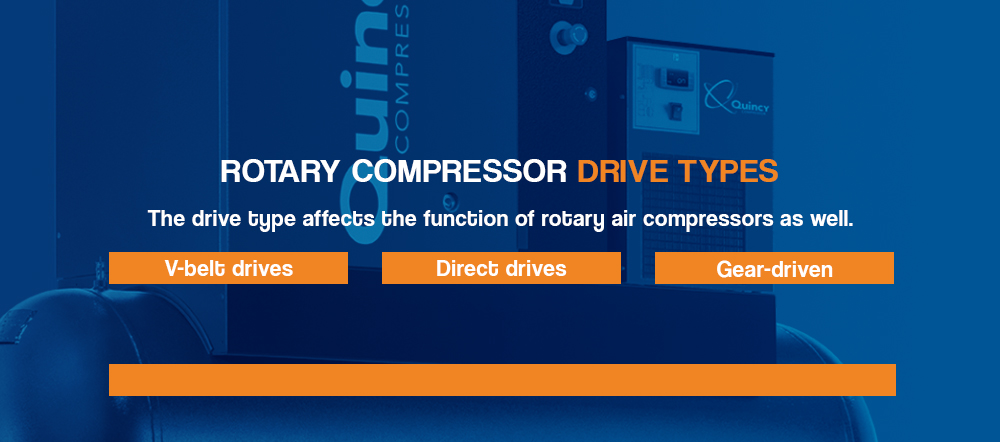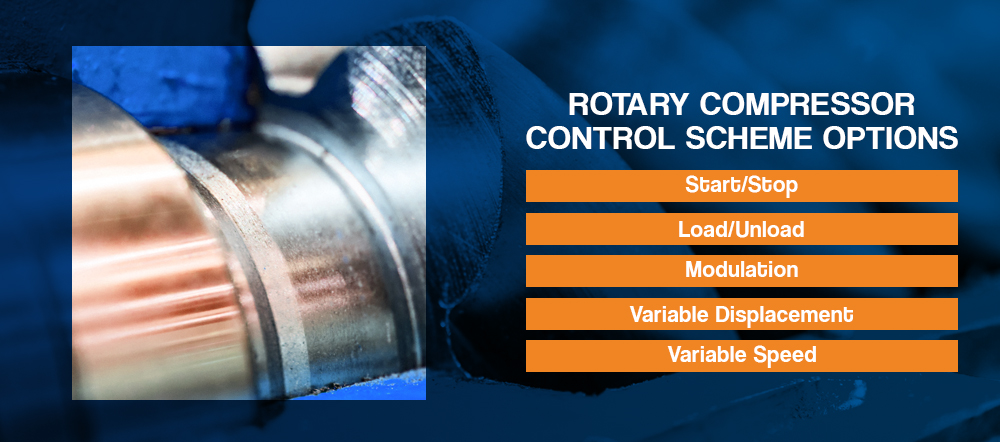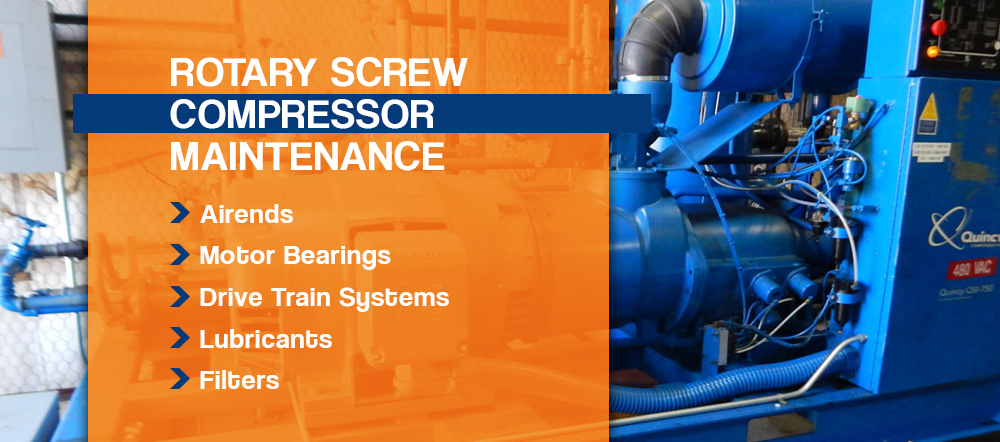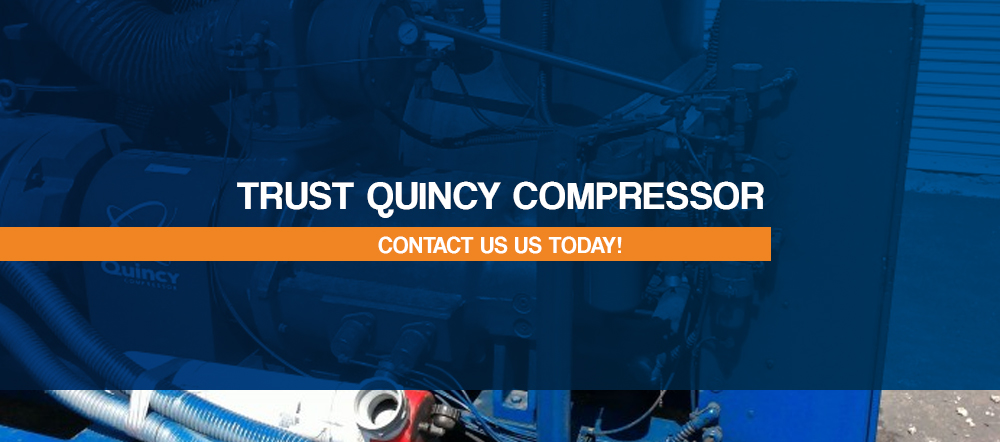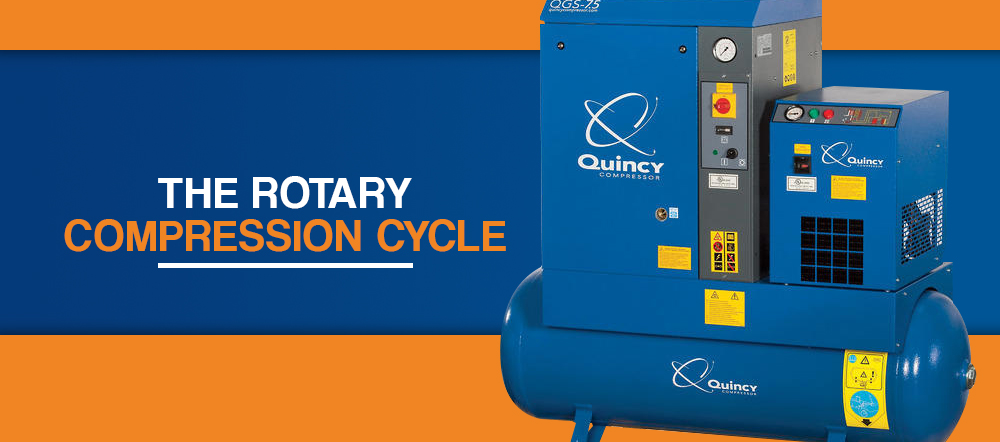
Rotary screw compressors power a multitude of different manufacturing processes. In any factory where goods are made, you are almost certain to find at least one rotary screw air compressor at work. Industrial rotary screw compressors offer the advantage of a 100% duty cycle and the ability to stay in operation 24 hours a day. While a piston compressor needs intermittent breaks to function optimally, a rotary screw compressor actually works better with continuous use.
Sizing rotary screws correctly and ensuring efficient design in the air system and compressor control results in highly energy-efficient compression. We’ll go over how rotary screw compressors work and how to keep them in top shape for optimum longevity.
How Does a Rotary Compressor Work?
When the average person thinks about an air compressor, they imagine a reciprocating air compressor which is powered by pistons. These types of compressors use pistons to move air into a small space and subsequently collect the resulting compressed air inside a receiver tank. While these compressors have been in use for decades and are relatively inexpensive, they aren’t necessarily the best option for producing compressed air.
Rotary screw air compressors use a positive displacement mechanism based on two screws that rotate in precise alignment. These interlocking rotors reduce the volume of air and increase its pressure.
How Do They Compress Air?
The rotary screw compressor principle relies on a close meshing of the male and female rotors. As air enters the compressor, it is trapped between the rotors and is reduced in volume. The rotary screw compressor cycle works as follows.
- The inlet valve takes in atmospheric air.
- The air travels down the system’s pressure line to a regulator valve responsible for setting the system’s overall pressure.
- Air and oil mix and are compressed by the rotors in the airend.
- The air discharge hose transports the air and oil mixture away from the airend.
- The air and oil mixture enters the first oil separator tank which removes the majority of the oil from the air.
- Air then flows through the secondary separation filters that remove the rest of the oil mist.
- Clean air flows out of the system and is collected in the receiver tank, if one is being used.
- Oil flows into the cooler and is reduced to an appropriate temperature before flowing to an oil filter.
- The oil filter screens out any remaining contaminants in the oil.
- The clean, recycled oil returns to the airend through what’s called a scavenge line.
Although envisioning the rotary screw compressor cycle as a sequence of steps helps clarify the operation of the machine, the steps do not actually occur sequentially. Once the compressor is turned on, all the listed steps start happening simultaneously and continue until the machine is turned off.
Benefits of Rotary Screw Compressors
Let’s take a look at the advantages of rotary screw compressors and why the cycle is advantageous compared to other compressor types.
- Safety and convenience: Rotary screw air compressors can deliver continuous air compression for many purposes, and the fact that the screws are secured in a housing makes them safer to operate.
- Functionality in extreme conditions: Rotary air compressors can function in both high and low temperatures where other types of compression can’t be used.
- Better power generation: These compressors have very high air flow rates and are designed to generate enough power for high-demand applications.
- Easier maintenance: The design of rotary air compressors is impressively streamlined, and these compressors have far fewer parts than others.
- Quiet operation: This form of air compression is much quieter than compression from pistons, and many rotary screw compressors have noise-dampening features to quiet operating noise even more.
- Energy efficiency: The rotary screw compressor cycle generates less heat than traditional air compressors, resulting in greater conservation of energy.
- Less oil consumption: Oiled rotary compressors operate using less oil than other types of flooded compressors and have a minimum carryover of oil as well.
- Designed for the long term: Quality rotary screw air compressors can last many years and have little to no reduction in capacity.
In both the short and long term, the initial extra cost of a rotary compressor pays for itself through these efficiencies.
Rotary Screw Compressor Components
Each component in the system is critical to how rotary screw compressors work. The heart of a rotary air compressor is the airend. This is the area where the air is actually compressed. The airend has an inlet valve that takes in air and mixes it with oil during the compression process. The system then separates oil from the air, and the air exits the system. Although the airend is the site of the compression itself, the following additional components are all essential to the rotary screw compressor cycle.
Air Filter
Not all air is created equal, and the quality of the air going into the compressor influences the system’s longevity. Filtering air before it reaches the inlet valve is essential, especially in applications where ambient air is less than clean. Air filters can be mounted right onto the compressor, or placed remotely and connected with a hose. When placing the air filter, look for an area with the coolest, cleanest air for best results.
Primary Separation Tank
As compressed air makes its way out of the airend, it gets mixed up with the compressor oil. The primary separator tank is where the initial round of filtration occurs. Both centrifugal force from spinning and mechanical separation work together to form oil droplets. These droplets then fall to the bottom, making this tank a functional oil reservoir in many cases.
Secondary Separation Filter
After compressed air exits the primary separation tank, nearly all oil is gone, but it requires another filtration to get completely clean. The oil mist and air mixture that remains goes through a coalescing filter in the secondary tank. Coalescing filters use membrane-like material that catches the oil particulate and directs it back to the central oil system. Air exiting the filter at this point will be free of oil and ready for use.
It’s common for the secondary separation filter to be connected directly to the primary tank, although you can also mount it remotely with a dedicated filter manifold.
Oil Filter
A rotary screw compressor uses an oiling system on a closed loop. This means that the installation must use an oil filter. The oil filter’s job is to collect any loose particles that have collected in the oil and shouldn’t re-enter the air compressor system. An oil filter can be placed at any one of multiple intervals on the compressor loop.
Oil Cooler
There is a significant amount of heat produced during air compression, which causes the oil to get extremely hot. To cool it down, the oil is put through a separate cooler before being recycled to the compressor again. A rotary compressor may use a liquid-to-liquid cooler or air-to-liquid cooler in combination with engine cooling.
The liquid-to-liquid approach requires enough cooling power to reduce heat in the compressor oil in addition to the engine cooling. If you are going for air-to-liquid cooling, you need enough clean and low-temperature air to maintain oil temperature within the right range.
Hoses
The importance of hoses cannot be underestimated in rotary screw compressor operations. Choosing a hose that doesn’t fit the specifications of pressure, heat and chemical components of the oil used will create excess wear and tear that results in hose failure. Such failures can be extremely dangerous and may result in you needing to repair or replace the entire compressor in some cases.
Oil vs. Non-Oil Rotary Compressors
Oil-free compressors don’t have the help of an oil seal, meaning that compression is achieved solely through the rotor action. As a result, oil-free compressors generally have a lower maximum discharge capacity than their oiled counterparts. However, systems in which multiple sets of screws compress the air, pressure and output volume can be comparable to oiled compressors.
There isn’t any oil for sealing purposes, so the rotors have to be as precise as possible and cannot tolerate much deviance. The screws do not touch, but the gap between them has to be tiny for the best performance. In oil-free compressors, water moves through specified paths in the element casing to cool the air down. This only cools down the casing, leaving the air and rotors in need of further cooling.
To get around this inefficiency, oil-free compressors contain two stages of compression. In the first stage, air is compressed to around 50 pounds per square inch (psi) and then goes through an intercooler before the second stage compresses the air to 100 psi.
Oil-free compressors are necessary for industries and applications where oil carryover is unacceptable. These include high-precision applications like medical research or the manufacture of complex products like semiconductors. However, just because the air produced by an oil-free compressor doesn’t have oil does not mean filtration can be skipped. The resulting air may contain hydrocarbons or other contaminants that have to be removed. Due to this requirement, oil-free compressors still need the same air treatment as oil-injected compressors to assure quality.
Oil-Injected Compressors
During the rotary screw compressor cycle of an oil-injected system, the injected oil helps seal cavities and creates a heat sink that cools the gas charge. After injection, the system separates oil from the stream for cooling, filtration and recycling. The oil reduces the particle load in filtration by capturing non-polar particulates from the ambient air intake. Some of the compressor oil may move into the compressed air stream, which can be prevented with the use of coalescing filters.
Coalescing filters downstream of an air dryer are less effective at removing oil and water from the air than refrigerated air dryers that have internal cold filters. After the compressed air is cooled and free of moisture, the now-cold air helps cool down the entering air and simultaneously warms up the air leaving the system. Receiver tanks allow oil to form droplets and fall out of the air for removal.
Rotary Compressor Drive Types
The drive type affects the function of rotary air compressors as well. The three basic types of drives for air compressors are:
- V-belt drives: These are beneficial for those who want a smaller sized enclosure. They offer simple maintenance and their level of alignment is not as critical to proper function.
- Direct drives: Although direct drives are larger than others, they are significantly quieter. They also eliminate the need for belt and gear maintenance.
- Gear-driven: Gear-driven airends do not have alignment issues. They are typically used for compressors with high horsepowers, and the speed of the compressor can differ from the speed of the motor.
The type of drive you choose will depend on multiple elements like the compressor’s speed requirements and the recommendations of the compressor manufacturer. It is also possible to combine any of these drive types with a variable speed motor.
Rotary Compressor Control Scheme Options
Rotary screw compressor operations are governed by different control schemes. Let’s take a look at the benefits and drawbacks of each.
Start/Stop
Start/stop control schemes use actuated relays that provide or cut off power to the compressor motor as indicated by the application’s need for compressed air. If the load isn’t well-matched to the compressor or the load is intermittent, there will be a significant amount of storage space needed. In some cases, the necessary storage space is actually bigger than the compressor’s footprint.
Load/Unload
This scheme keeps the compressor powered continuously. It uses a slide valve to respond to a change in the need for compressed air. When less compressed air is needed, the slide valve moves to uncover a portion of the rotor. This reduces the machine’s capacity, unloading the compressor instead of disconnecting the power altogether. By reducing the number of starts and stops, load/unload control schemes extend the compressor’s service life without incurring a significant operating cost change. This control scheme is the most common among air compressor manufacturers.
A load/unload control scheme can be used with a timer. The timer will stop compressor operation after a specified amount of time with unloaded use. This is called an auto-dual or dual-control scheme. Because there are just two production rates, this scheme does require a fair amount of storage. However, the space requirements are much less than those of a start/stop scheme.
Modulation
This control scheme also uses a valve slide to alter the capacity in response to demand, but the capacity is modulated continuously rather than in discrete steps. The benefit of continuous modulation is a consistent discharge pressure even across many levels of demand, but the drawback is a higher consumption of power.
Modulation is not particularly efficient as a control scheme compared to variable-speed drives, which we will discuss below. However, some applications make it impractical or impossible to start and stop the compressor frequently. In these applications, like compressors powered by internal combustion engines, modulation is a good choice. Modulation also reduces the need for storage due to its variable production rate.
Variable Displacement
Variable displacement allows air to bypass a certain portion of the rotors, changing the percentage of screws that work to compress the air. Compared to modulation control schemes, variable displacement consumes less power. However, systems with large storage amounts may be better suited to a load/unload scheme. When large storage amounts aren’t practical, variable displacement is a good option.
Sometimes, variable displacement is achieved through the use of multiple valves on the compressor’s suction side. These valves all have a corresponding location on the compressor’s discharge. This works like a bypass valve in automotive superchargers.
Variable Speed
As long as it is properly maintained, a compressor with a variable-speed control scheme will produce the lowest operating costs in terms of energy and the scheme will not create a significant reduction in the compressor’s service life. If the demand for air is constant, the economic advantages are somewhat reduced due to the variable frequency power inverted necessary to the design.
That said, variable speed schemes create an almost linear relationship between the compressor’s consumption of power and the delivery of air. This facilitates highly efficient operation over a large demand range. During very low demand periods, the compressor still has to function on a start/stop mode and efficiency will drop quickly in response to rotor leakage. In areas that are dusty, hot or humid, variable speed control electronics may require extra protection and maintenance to preserve service life.
Rotary Screw Compressor Maintenance
When it comes down to the operation of a rotary screw air compressor, how it works is affected by whether the compressor receives all the maintenance recommended by the manufacturer. Maintenance is typically performed on a pre-determined timetable or according to the machine’s running hours. Running hours are a more reliable indicator of maintenance needs, although keeping track of them requires precise logging. Many of today’s air compressor controls have diagnostic and troubleshooting features that let you know what parts and services you may need. There are five main areas of an air compressor that require maintenance:
- Airend
- Motor
- Drive train
- Lubricants
- Filters
1. Airends
Air contamination, lubricants and excessive heat all contribute to airend damage. Check to ensure you don’t hear any unusual sounds or feel any vibrations. Airends need to be rebuilt periodically, with many manufacturers suggesting rebuilding around the 50,000- or 60,000-hour mark to ensure you don’t run into forced downtime.
2. Motor Bearings
Motor bearings need proper lubrication with specific amounts and types of lubricants in to last the longest. The bearings should be replaced more frequently than other parts to ensure compressor longevity. Check ampere draw regularly and make sure the motor doesn’t get overloaded.
3. Drive Train Systems
Alignment is the main concern in air compressor drive train systems. Any misalignment will cause unnecessary damage to the coupling if the mounting block or frame settles. V-belts need to be inspected and potentially adjusted after every 500 hours, and belts that are at all frayed or show signs of wear need to be replaced.
4. Lubricants
To get the cooling, sealing and protectant benefits of lubricants, change the oil according to the manufacturer’s instructions for the specific applications. Always use lubricants specified for your compressor model and be sure to drain all the old lubricant out before refilling the machine.
5. Filters
It is far more cost-effective to implement adequate filtration first than to pay for repairs on equipment damaged by contaminated air. Be sure to inspect the inlet filters regularly and replace them when necessary. A common replacement interval is every 2,000 hours.
General Cleaning
General cleanliness is an important part of air compressor maintenance, too. Any soiling of the compressor surfaces can end up increasing the temperature of your compressed air, which reduces output and increases the power required to produce the air.
Trust Quincy Compressor
Quincy Compressor has been innovating engineered solutions for 100 years, and our expertise is evident in the quality of our products. As a leading designer and manufacturer of rotary screw air compressors, we provide the performance you demand and the reliability you trust. Our compressors come with industry-leading warranties and 24-hour service from dedicated Quincy Dealers.
We also offer all the parts you need to maintain your compressor and keep up with demand. Whether you need a new air compressor, parts or service for your existing compressor, it’s as simple as finding the nearest Quincy Compressor Sales & Service representative and letting us know what you need.


